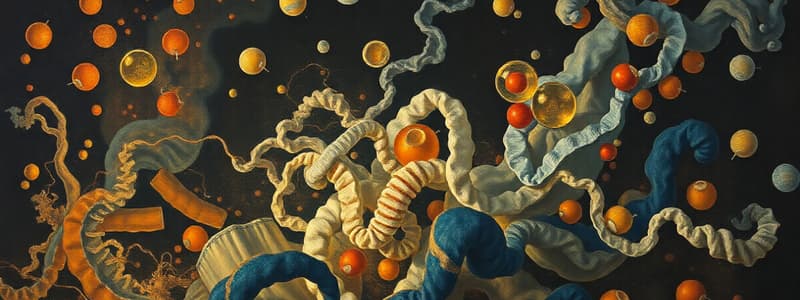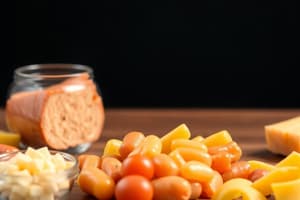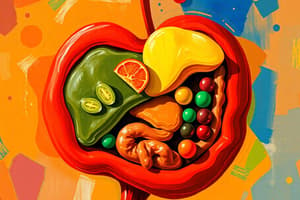Podcast
Questions and Answers
Which of the following is a direct precursor for the synthesis of nonessential amino acids?
Which of the following is a direct precursor for the synthesis of nonessential amino acids?
- Intermediates of metabolism only
- Both essential amino acids and metabolic intermediates (correct)
- Fatty acids and glycerol
- Essential amino acids only
What process describes incorporating nitrogen during biosynthesis, relative to the separation of amino groups?
What process describes incorporating nitrogen during biosynthesis, relative to the separation of amino groups?
- The oxidation process
- An unrelated metabolic pathway
- A parallel catabolic process
- A reversed chemical reaction (correct)
What are the two main stages in the degradation of amino acids?
What are the two main stages in the degradation of amino acids?
- Decarboxylation and reamination
- Separation of the amino group and the metabolism of the carbon skeleton (correct)
- Glycolysis and gluconeogenesis
- Transamination and lipolysis
From what amino acid is dopamine synthesized?
From what amino acid is dopamine synthesized?
Which biogenic amine is associated with inflammatory reactions, gastric acid secretion, and neural transduction?
Which biogenic amine is associated with inflammatory reactions, gastric acid secretion, and neural transduction?
Porphyria is a disorder related to problems in the synthesis of which of the following?
Porphyria is a disorder related to problems in the synthesis of which of the following?
What are the key sources for nitrogen used in purine synthesis?
What are the key sources for nitrogen used in purine synthesis?
What are the primary nitrogen sources for pyrimidine synthesis?
What are the primary nitrogen sources for pyrimidine synthesis?
What is the primary function of proteolytic enzymes in the context of protein digestion?
What is the primary function of proteolytic enzymes in the context of protein digestion?
In amino acid degradation, what is the primary role of transamination?
In amino acid degradation, what is the primary role of transamination?
Which molecule serves as a primary acceptor of amino groups during transamination, leading to the formation of glutamate?
Which molecule serves as a primary acceptor of amino groups during transamination, leading to the formation of glutamate?
What is the direct product of oxidative deamination?
What is the direct product of oxidative deamination?
Which of the following statements accurately describes the direction of the glutamate dehydrogenase (Glu DH) reaction?
Which of the following statements accurately describes the direction of the glutamate dehydrogenase (Glu DH) reaction?
What is the significance of the urea cycle in the context of amino acid metabolism?
What is the significance of the urea cycle in the context of amino acid metabolism?
What is the function of Alanine Aminotransferase (ALT)?
What is the function of Alanine Aminotransferase (ALT)?
Besides free ammonia (NH3), what is the other direct source of nitrogen incorporated into urea during the urea cycle?
Besides free ammonia (NH3), what is the other direct source of nitrogen incorporated into urea during the urea cycle?
Flashcards
Carbon Skeleton Metabolism
Carbon Skeleton Metabolism
The process by which the carbon skeletons of amino acids are broken down and used for energy or biosynthesis.
α-Carbon
α-Carbon
The central carbon atom in an amino acid, to which the amino group, carboxyl group, and side chain are attached.
Glucogenic Amino Acids
Glucogenic Amino Acids
Amino acids that can be converted into glucose through gluconeogenesis.
Ketogenic Amino Acids
Ketogenic Amino Acids
Signup and view all the flashcards
Both Glucogenic and Ketogenic Amino Acids
Both Glucogenic and Ketogenic Amino Acids
Signup and view all the flashcards
Amino Acid Degradation
Amino Acid Degradation
Signup and view all the flashcards
Nitrogen-containing Compound Synthesis
Nitrogen-containing Compound Synthesis
Signup and view all the flashcards
Biogenic Amines
Biogenic Amines
Signup and view all the flashcards
Protein Digestion
Protein Digestion
Signup and view all the flashcards
Transamination
Transamination
Signup and view all the flashcards
Oxidative Deamination
Oxidative Deamination
Signup and view all the flashcards
Urea Cycle
Urea Cycle
Signup and view all the flashcards
Alanine Aminotransferase (ALT)
Alanine Aminotransferase (ALT)
Signup and view all the flashcards
Glucose-Alanine Cycle
Glucose-Alanine Cycle
Signup and view all the flashcards
Aminotransferases
Aminotransferases
Signup and view all the flashcards
Study Notes
Metabolism of Nitrogenous Compounds
-
Learning objectives include describing protein digestion, reactions separating amino groups, fate of carbon skeletons, glucogenic and ketogenic amino acids, biogenic amines, and examples of nitrogenous compounds.
-
Nitrogenous compounds include amino acids (proteins), biogenic amines, porphyrins, and nucleobases.
-
Amino acid metabolism: Dietary protein is degraded into amino acids, which can be used for energy or protein synthesis and used to create other N-compounds. Amino acids can be converted into keto acids and then into glucose or fat. Removal of amino groups from amino acids produces urea as a byproduct.
-
Protein digestion: Proteins start to be digested in the stomach where proteases break peptide bonds. The process continues in the small intestine with endopeptidases, separating proteins into di- and tripeptides and amino acids that can be absorbed.
-
Amino acid degradation: The process of separating amino groups from amino acids via transamination or oxidative deamination. The remaining carbon skeleton is further metabolized.
-
Amino acid degradation, separation of amino group: Transamination, transferring amino groups to another molecule such as a-Ketoglutarate. Oxidative deamination, creation of free ammonia (NH4+).
-
Formation of Glutamate: A-Ketoglutarate receives the amino group to form glutamate. Lysine and Threonine are exceptions, and some aminotransferases (transaminases) have specific substrate preferences.
-
Amino acid degradation - Aminotransferases reactions: Aminotransferases transfer amino groups from an amino acid to a-ketoglutarate to create glutamate.
-
Urea cycle: Ammonia is toxic so the body transforms it into urea, a less toxic molecule. The urea cycle incorporates ammonia and aspartate into urea to be excreted.
-
Importance of Urea Cycle: Urea is a less toxic molecule produced in the liver from ammonia. It is transported to the kidneys to be excreted.
-
Nucleotide metabolism: Nucleotides are composed of a phosphate group, a pentose sugar, and a nitrogenous base. Includes the synthesis of purines and pyrimidines that are nitrogenous bases from other small molecules.
-
Porphyrins and degradation disorders : Defects in the synthesis of porphyrins, can lead to various disorders and jaundice which is yellowing of the skin and eyes. Biogenic amines: A group of amines derived from amino acids. These include, but are not limited to histamine, serotonin, and the catecholamines (dopamine, norepinephrine and epinephrine).
Studying That Suits You
Use AI to generate personalized quizzes and flashcards to suit your learning preferences.




